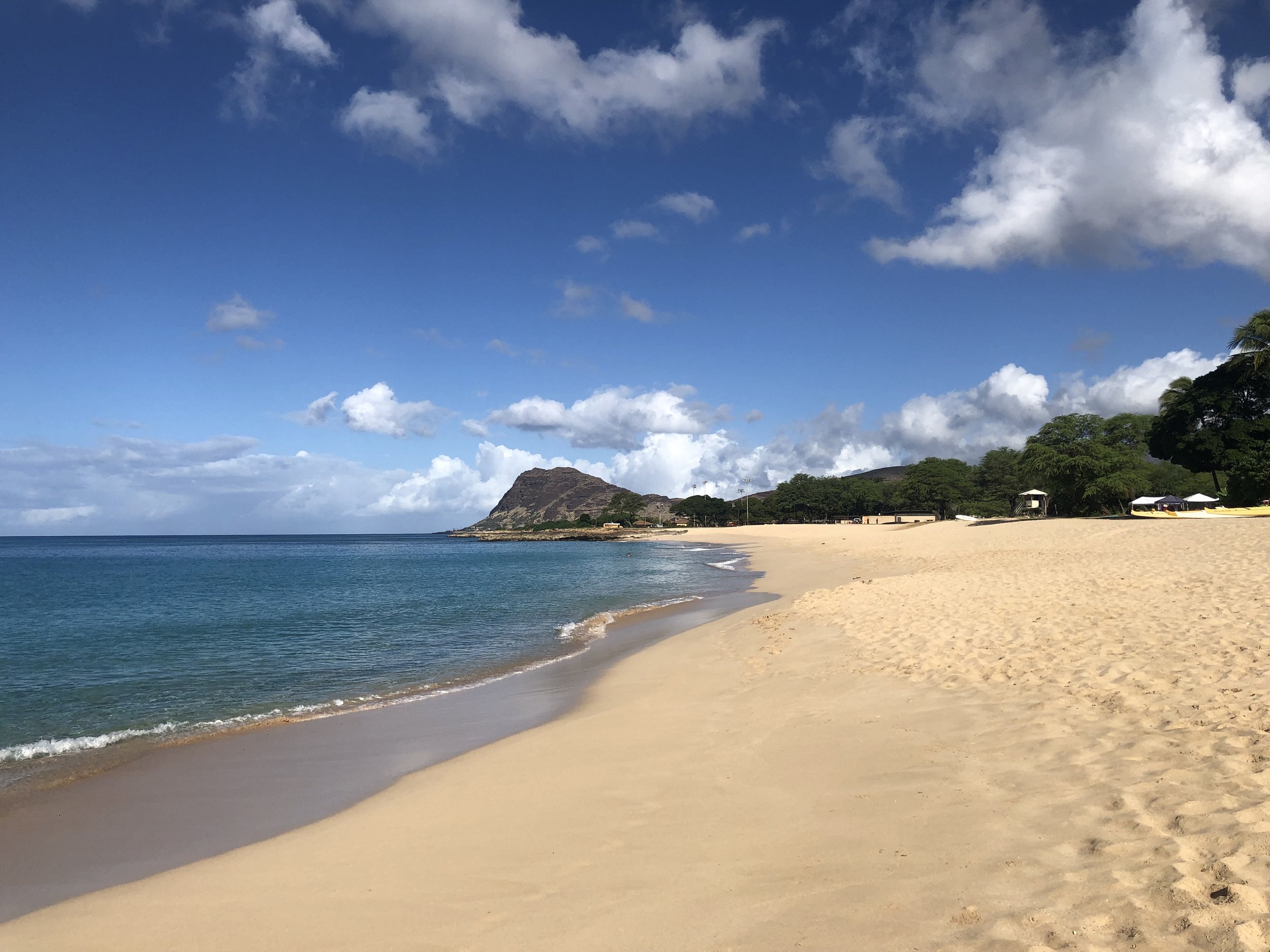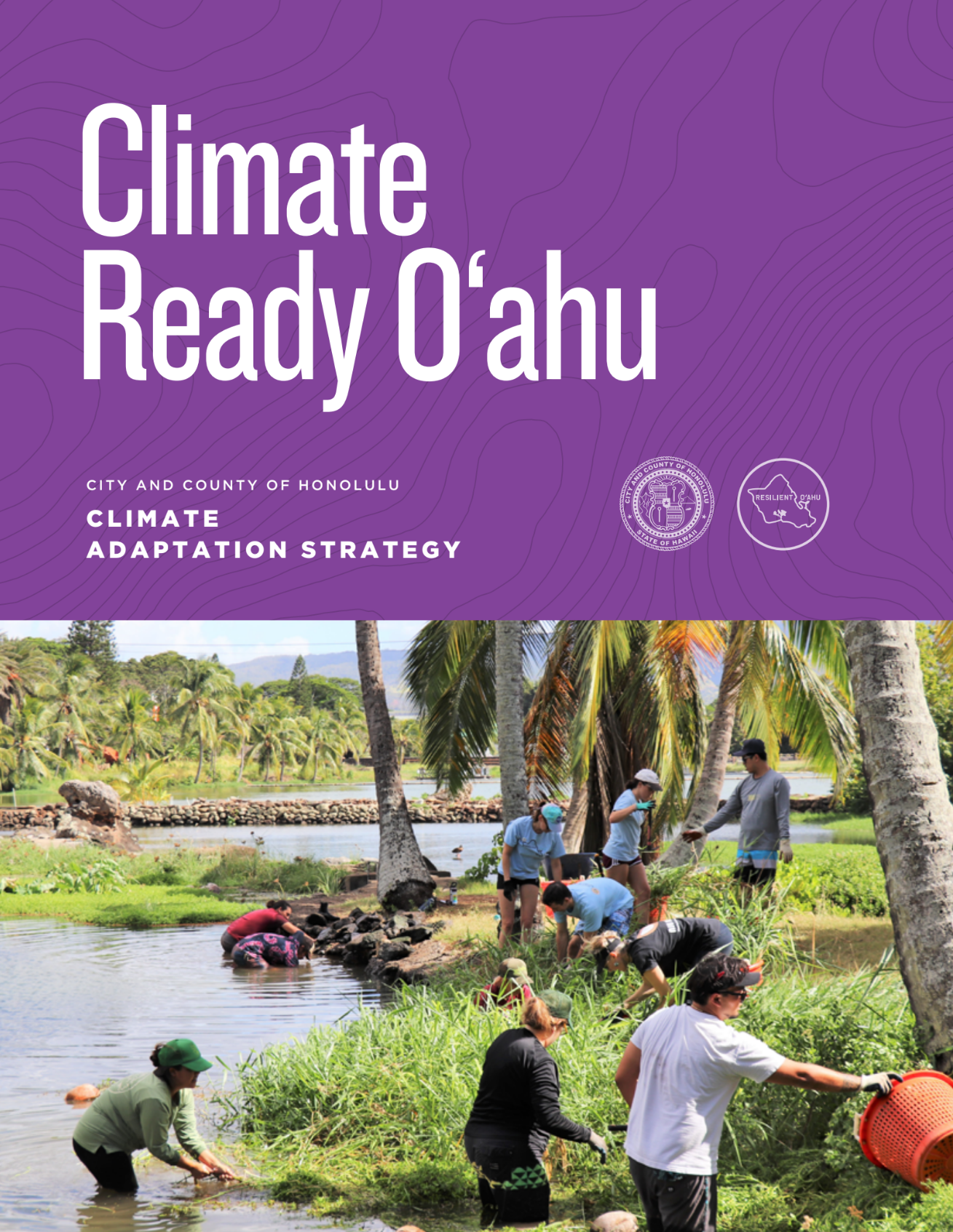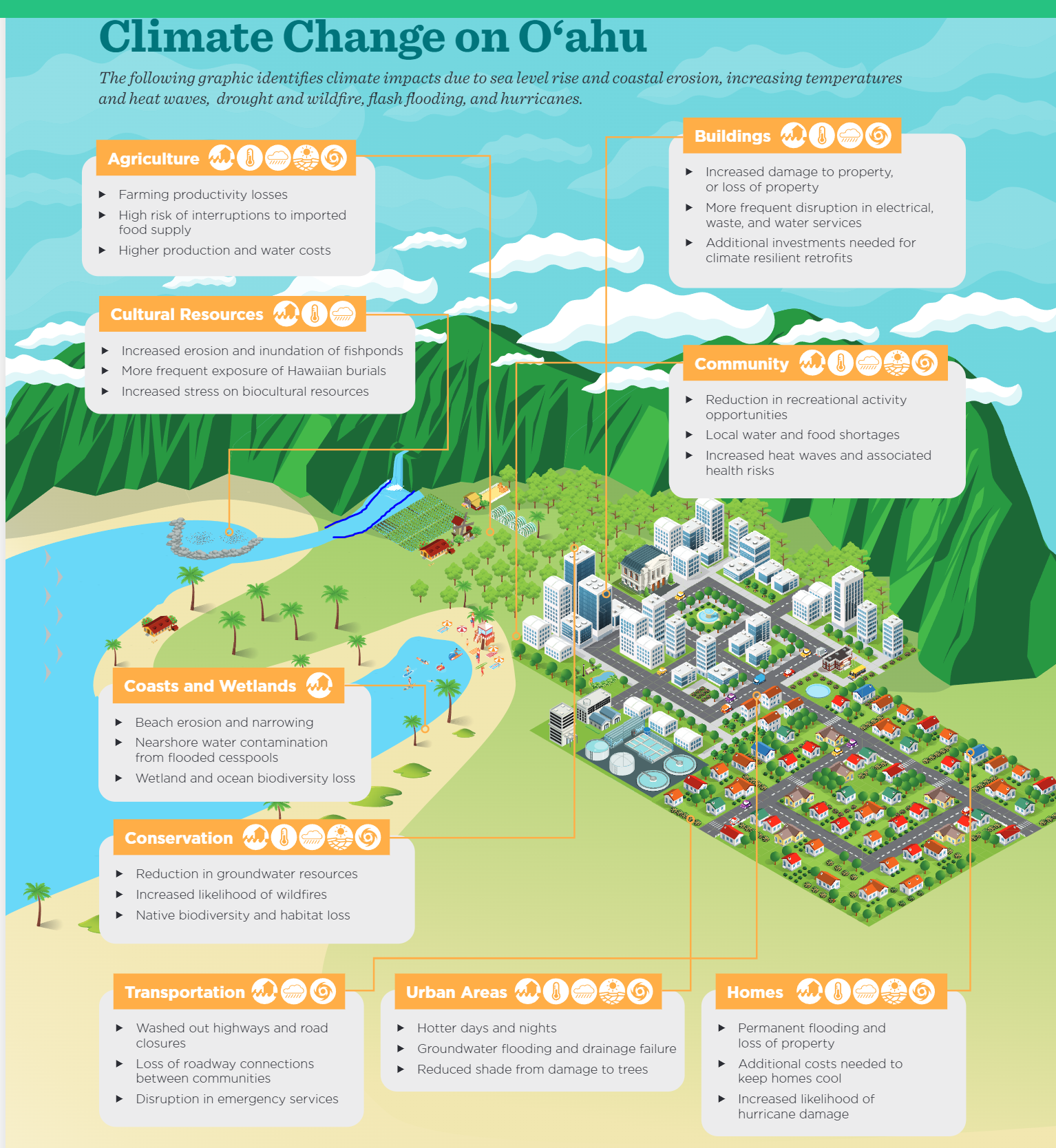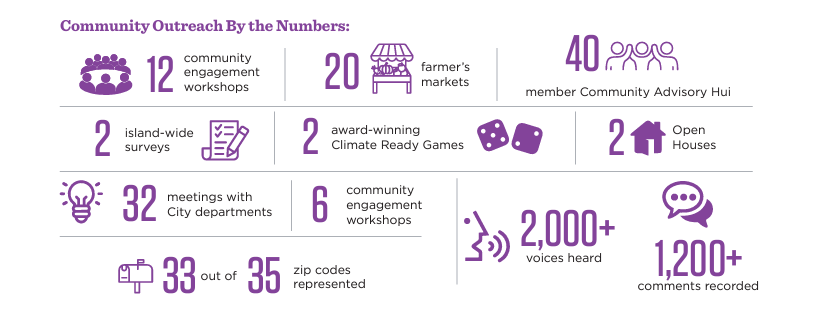
Climate Ready Oʻahu
Climate Ready Oʻahu
Stopping the cause of climate change is a global responsibility, but adapting to impacts is a local one.
Climate Ready Oʻahu is a science-based, community-driven strategy for Oʻahu to adapt to the impacts of climate change. It recognizes that even if we stopped emitting all greenhouse gas emissions that cause climate change tomorrow, past emissions have locked us into a warming path to some degree, meaning some climate impacts are unavoidable. .
Climate Ready Oʻahu lays out a detailed list of strategies, policies, and actions that the City can take, alongside individual, community, state and federal actions, to prepare, protect, and safeguard community members, ʻāina, and infrastructure from climate hazards today and for generations to come.
Climate Ready Oʻahu was adopted by the City Council in February 2024.

What does climate change look like on Oʻahu?
Climate Ready Oʻahu is responsive to five key hazards:
Increasing Temperatures
Rising Sea-Levels
Increasing Precipitation
Drought and Wildfire
Hurricanes
From social and cultural systems to the places we live, work, and play, climate hazards can impact our island in many ways. This graphic explores different impacts of the five key climate hazards.
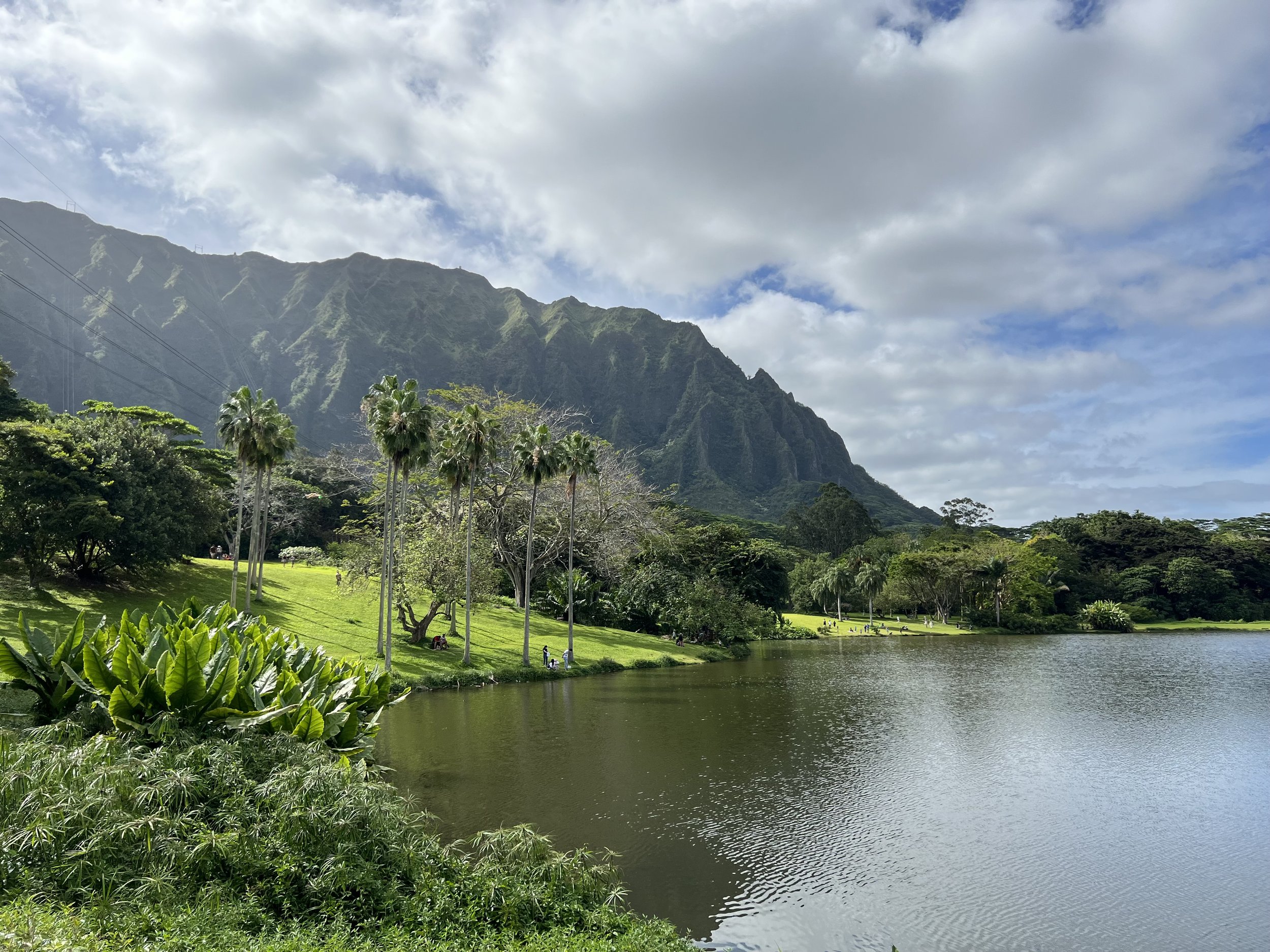
Climate Adaptation at a Glance
One Vision in 3 Parts, 12 Strategies, 57 Actions for a Climate Ready O’ahu
From the Adaptation Strategy, pages 128-130
Vision 1: Empowered and Prepared People
-
Action 1.1 Develop and distribute materials about climate hazards, their impacts, and how individuals can take action to prepare.
Action 1.2 Expand the City’s network of partners who serve frontline communities to check in on vulnerable neighbors during climate “shocks.”
Action 1.3 Provide training to public-service safety staff, outdoor workers, an caregivers to recognize and report patterns of heat-related illnesses injuries.
-
Action 2.1 Create a Climate Champions program to encourage local climate leadership.
Action 2.2 Encourage and support neighborhoods to become certified Firewise Communities.
Action 2.3 Create a resource hub to promote opportunities for engaging in community-led climate adaptation.
Action 2.4 Celebrate community action on climate adaptation.
-
Action 3.1 Recognize and compile educational resources on how Native Hawaiian cultural practices positively contribute to climate adaptation.
Action 3.2 Research climate impacts on Native Hawaiian cultural practices and resources.
Action 3.3 Assess and mitigate risk to iwi kūpuna from sea level rise and coastal erosion.
Action 3.4 Produce tools and guidance specific to climate indicators defined by Native Hawaiian communities.
Action 3.5 Identify and plan for climate impacts to historic sites and landmarks.
-
Action 4.1 Operationalize an Equity Screen for City projects to ensure equitable implementation of climate ready actions.
Action 4.2 Develop and monitor key adaptation metrics in collaboration with frontline community members.
Action 4.3 Improve language accessibility of climate-related information.
Vision 2: Safeguarded and Stewarded ʻĀina
-
Action 5.1 Utilize the expanded scope of the Clean Water and Natural Lands Fund to better protect and maintain beaches and wetlands.
Action 5.2 Establish wetland protection and restoration goals.
Action 5.3 Increase partnerships and investments to support cesspool conversions islandwide.
Action 5.4 Collaborate with the community to restore beach and dune systems in City beach parks.
Action 5.5 Explore the potential for a statewide Coastal Conservancy in coordination with the State and other counties.
-
Action 6.1 Slow and hold runoff in parks, open spaces, and roads to improve water quality and reduce flooding.
Action 6.2 Expand support of conservation, maintenance, and reforestation across all priority watersheds.
Action 6.3 Expand capacity and partnerships for stream maintenance.
Action 6.4 Adopt stream buffers to reestablish natural stream systems.
Action 6.5 Increase and improve the quality of buffer areas around wildfire prone areas.
-
Action 7.1 Expand recycled water infrastructure and plans for water reuse.
Action 7.2 Adopt a plumbing “reach code” to incentivize water efficiency.
Action 7.3 Incentivize water efficiency upgrades in buildings and homes.
Action 7.4 Expand the use of non-potable water.
-
Action 8.1 Evaluate underutilized City lands to grow the local food system.
Action 8.2 Catalyze the use of Climate Smart Agricultural practices and technologies.
Action 8.3 Commission a study on impacts of climate change on agriculture.
Action 8.4 Create a climate adaptation resource network for farmers and food system stakeholders.
Action 8.5 Expand the City’s community garden network in underserved neighborhoods.
Action 8.6 Support increased long-term capacity to store, refrigerate, and distribute food.
Vision 3: Safe and Reliable Infrastructure
-
Action 9.1 Coordinate resilient infrastructure investments through the One Water Honolulu Panel.
Action 9.2 Integrate climate resilience principles into City budgeting processes.
Action 9.3 Improve understanding of flood risks by expanding and updating flood maps.
Action 9.4 Create a toolbox of innovative funding mechanisms for climate adaptation.
Action 9.5 Reduce the urban heat island effect by adding more shade to codes and standards.
-
Action 10.1 Retrofit City facilities at risk from storms and flooding.
Action 10.2 Assess risk to public infrastructure from extreme heat.
Action 10.3 Incentivize wind and flooding retrofits for homes and businesses, especially in areas with low shelter availability.
Action 10.4 Develop sea level rise adaptation pathways for high priority infrastructure assets.
Action 10.5 Pilot cool and permeable alternatives to traditional pavements in parking lots, roads, and recreational spaces.
Action 10.6 Require use of Climate Change Design Guidelines for all Capital Improvement Projects.
-
Action 11.1 Update Flood Ordinance to require Freeboard in certain special flood hazard areas.
Action 11.2 Assess the adoption of climate resilient development standards via a sea level rise overlay zone.
Action 11.3 Critically evaluate the cost of relocating infrastructure out of the sea level rise exposure area versus repairing and maintaining infrastructure in place.
Action 11.4 Develop priority options for smart redevelopment and managed retreat for areas vulnerable to sea level rise.
-
Action 12.1 Update the City’s street and park tree inventory to better maintain and grow the urban tree canopy.
Action 12.2 Facilitate cooling solutions and retrofits to protect residents from increasing temperatures.
Action 12.3 Establish shade quotas along multi-modal transit corridors, in public recreation spaces, and in other public facilities.
Action 12.4 Develop a “Heat Hazard Annex” for the Emergency Operations Plan.
Action 12.5 Assess risk to community health and safety from increasing temperatures and heat waves.
Action 12.6 Increase availability of public drinking fountains.
Action 12.7 Maximize installation of solar PV over parking lots to mitigate urban heat.
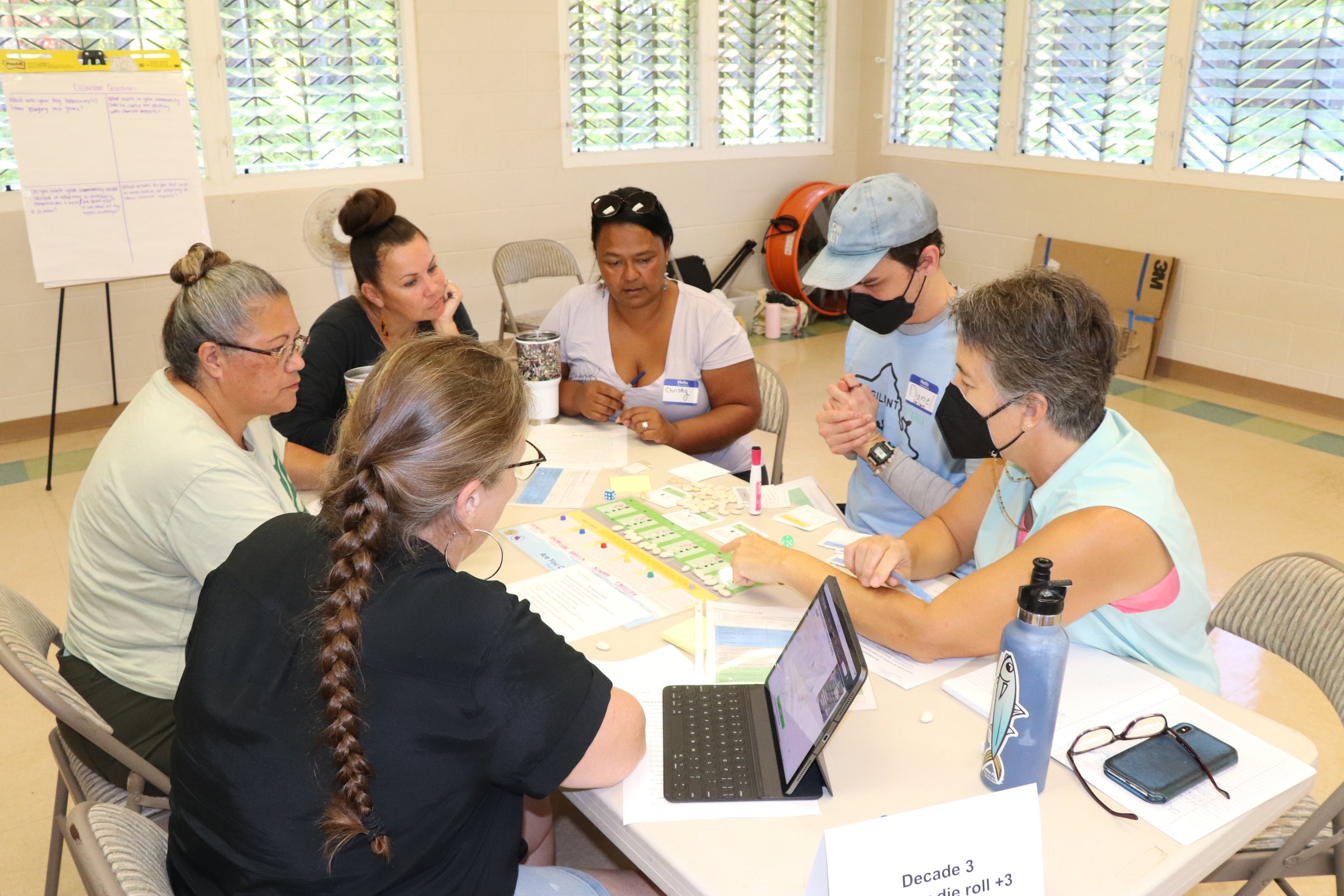
Built on
Community Voices
Climate Ready Oʻahu is built on a foundation of community voices, including an Advisory Hui, City staff, and more than 2,000 residents who were engaged through surveys, workshops, open houses, a public comment period, and other community engagement efforts.
The City released a draft plan for public comment in November 2023 and reviewed community’s input for incorporation into the final strategy. If you weren’t able to comment, you can read the City’s responses to draft plan public comments.
